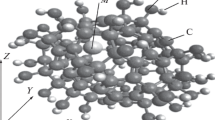Abstract.
17O NMR and 1H NMRD studies have been performed on a series of Gd(III) 1,4,7,10-tetraazacyclododecane-1,4,7,10-tetraacetic acid (DOTA) derivatives as potential liver-specific magnetic resonance imaging (MRI) contrast agents. They bear aliphatic side chains which make them capable of micellar self-organization. The compounds differ in the length (C10–C18) and in the chemical nature (alkyl or monoamide-alkyl) of their lipophilic chain. We have established a convenient method to determine the critical micellar concentration (cmc) of paramagnetic surfactants by 1H relaxivity measurements. This technique can be easily used over a large temperature range; thus, it can find wide application outside the field of MRI contrast agents. The knowledge of the cmc allowed us to determine the parameters governing the water proton relaxivity of the Gd(III) chelates in both nonaggregated and aggregated micellar forms. The relaxation data of the micellar complexes have been interpreted with the Lipari–Szabo approach. This model allows a local motion to be separated from the global tumbling of the whole micelle (modulated by a local, τl, and a global, τg, rotational correlation time, respectively). The aggregation substantially affects the rotational dynamics and thus increases the proton relaxivity of the Gd(III) chelates. The global rotational correlation times increase with increasing length of the side chain (500–2800 ps for C10–C18). Local motions are also influenced by the length and by the hydrophobicity of the side chain. The analysis of the relaxation data reveals considerable flexibility for these micellar aggregates. The rate of water exchange obtained for these chelates is identical to that for [Gd(DOTA)(H2O)]– \( \left( {k_{{\rm ex}}^{{\rm 298}} = 4.8 \times 10^6 {\rm s}^{ - 1} } \right) \) , and is not sensitive either to micellization or to differences in the aliphatic chain. A relaxivity gain in such systems could be attained by simultaneously optimizing the water exchange by modifications of the chelate and increasing the micelle rigidity by using water-soluble surfactants with more hydrophobic side chains. Electronic supplementary material to this paper can be obtained by using the Springer Link server located at http://dx.doi.org/10.1007/s007750020353
Similar content being viewed by others
Author information
Authors and Affiliations
Additional information
Electronic Publication
Rights and permissions
About this article
Cite this article
Nicolle, G.M., Tóth, É., Eisenwiener, KP. et al. From monomers to micelles: investigation of the parameters influencing proton relaxivity. J Biol Inorg Chem 7, 757–769 (2002). https://doi.org/10.1007/s00775-002-0353-3
Received:
Accepted:
Issue Date:
DOI: https://doi.org/10.1007/s00775-002-0353-3




